Government Initiatives on Family Violence
VerifiedAdded on 2023/06/12
|11
|2987
|96
AI Summary
This article discusses the impacts of family violence on victims and the initiatives taken by the Australian government to address the issue. It covers the effects of family violence on health, children, and homelessness. It also talks about the programs implemented to prevent family violence, such as perpetrator programs, education for youth and children, and safety homes programs.
Contribute Materials
Your contribution can guide someone’s learning journey. Share your
documents today.
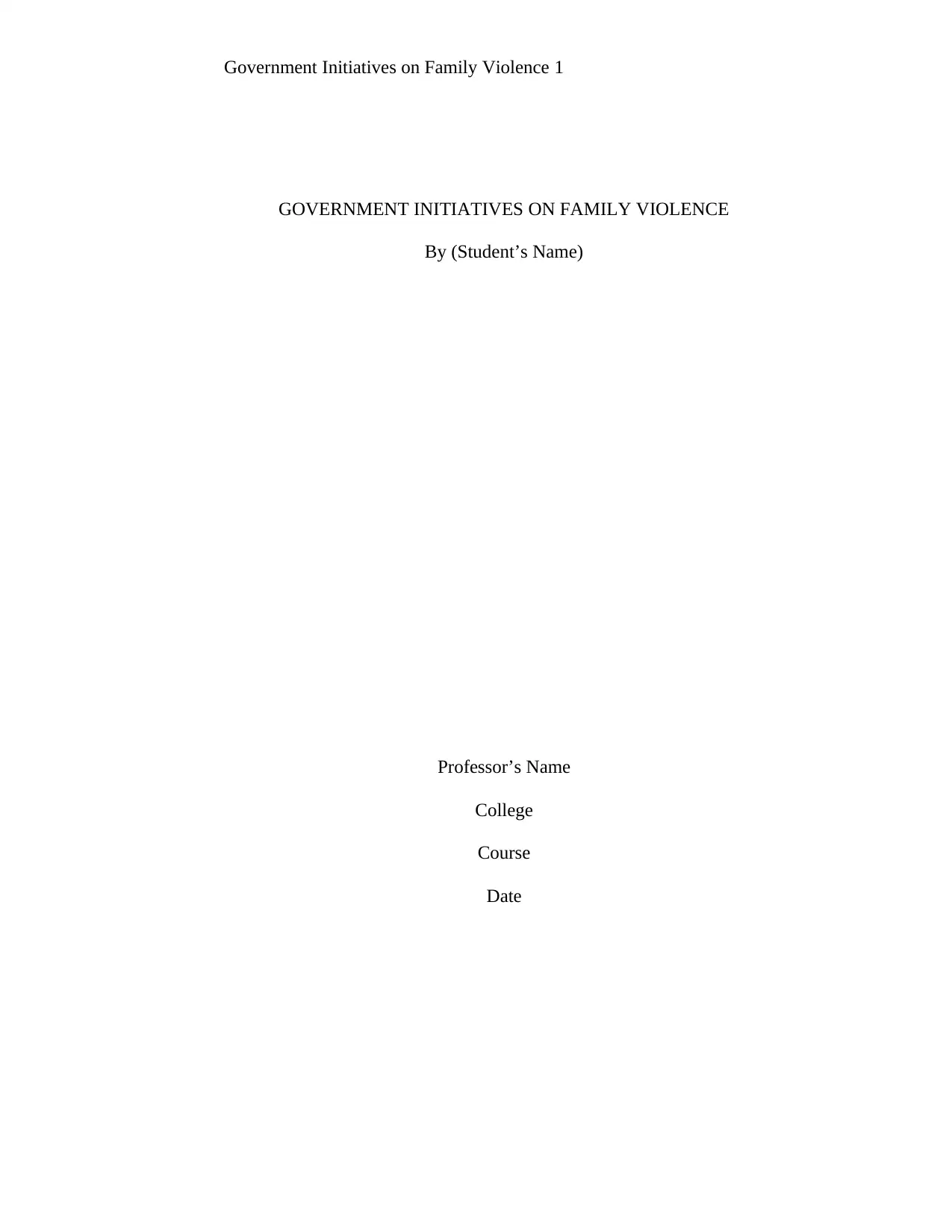
Government Initiatives on Family Violence 1
GOVERNMENT INITIATIVES ON FAMILY VIOLENCE
By (Student’s Name)
Professor’s Name
College
Course
Date
GOVERNMENT INITIATIVES ON FAMILY VIOLENCE
By (Student’s Name)
Professor’s Name
College
Course
Date
Secure Best Marks with AI Grader
Need help grading? Try our AI Grader for instant feedback on your assignments.
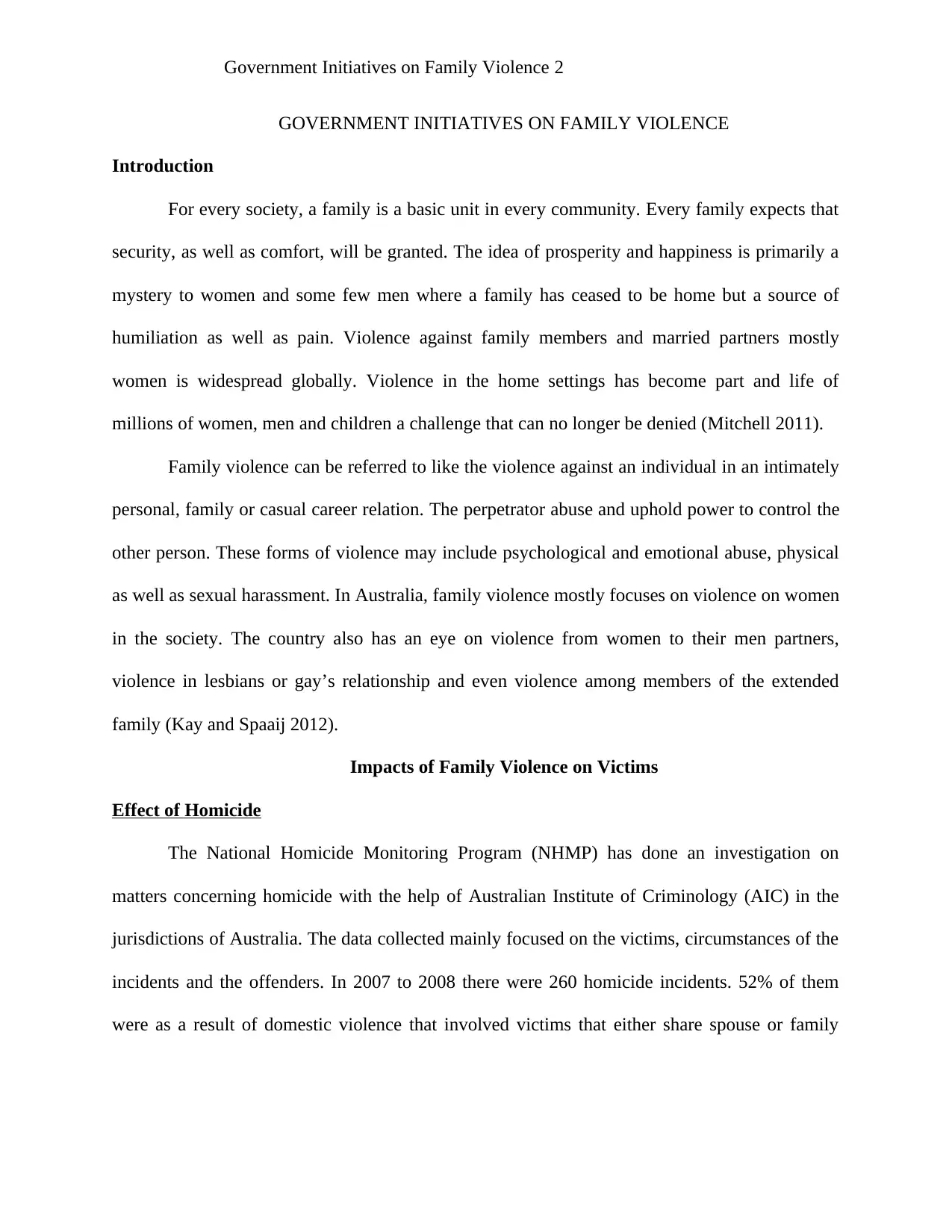
Government Initiatives on Family Violence 2
GOVERNMENT INITIATIVES ON FAMILY VIOLENCE
Introduction
For every society, a family is a basic unit in every community. Every family expects that
security, as well as comfort, will be granted. The idea of prosperity and happiness is primarily a
mystery to women and some few men where a family has ceased to be home but a source of
humiliation as well as pain. Violence against family members and married partners mostly
women is widespread globally. Violence in the home settings has become part and life of
millions of women, men and children a challenge that can no longer be denied (Mitchell 2011).
Family violence can be referred to like the violence against an individual in an intimately
personal, family or casual career relation. The perpetrator abuse and uphold power to control the
other person. These forms of violence may include psychological and emotional abuse, physical
as well as sexual harassment. In Australia, family violence mostly focuses on violence on women
in the society. The country also has an eye on violence from women to their men partners,
violence in lesbians or gay’s relationship and even violence among members of the extended
family (Kay and Spaaij 2012).
Impacts of Family Violence on Victims
Effect of Homicide
The National Homicide Monitoring Program (NHMP) has done an investigation on
matters concerning homicide with the help of Australian Institute of Criminology (AIC) in the
jurisdictions of Australia. The data collected mainly focused on the victims, circumstances of the
incidents and the offenders. In 2007 to 2008 there were 260 homicide incidents. 52% of them
were as a result of domestic violence that involved victims that either share spouse or family
GOVERNMENT INITIATIVES ON FAMILY VIOLENCE
Introduction
For every society, a family is a basic unit in every community. Every family expects that
security, as well as comfort, will be granted. The idea of prosperity and happiness is primarily a
mystery to women and some few men where a family has ceased to be home but a source of
humiliation as well as pain. Violence against family members and married partners mostly
women is widespread globally. Violence in the home settings has become part and life of
millions of women, men and children a challenge that can no longer be denied (Mitchell 2011).
Family violence can be referred to like the violence against an individual in an intimately
personal, family or casual career relation. The perpetrator abuse and uphold power to control the
other person. These forms of violence may include psychological and emotional abuse, physical
as well as sexual harassment. In Australia, family violence mostly focuses on violence on women
in the society. The country also has an eye on violence from women to their men partners,
violence in lesbians or gay’s relationship and even violence among members of the extended
family (Kay and Spaaij 2012).
Impacts of Family Violence on Victims
Effect of Homicide
The National Homicide Monitoring Program (NHMP) has done an investigation on
matters concerning homicide with the help of Australian Institute of Criminology (AIC) in the
jurisdictions of Australia. The data collected mainly focused on the victims, circumstances of the
incidents and the offenders. In 2007 to 2008 there were 260 homicide incidents. 52% of them
were as a result of domestic violence that involved victims that either share spouse or family
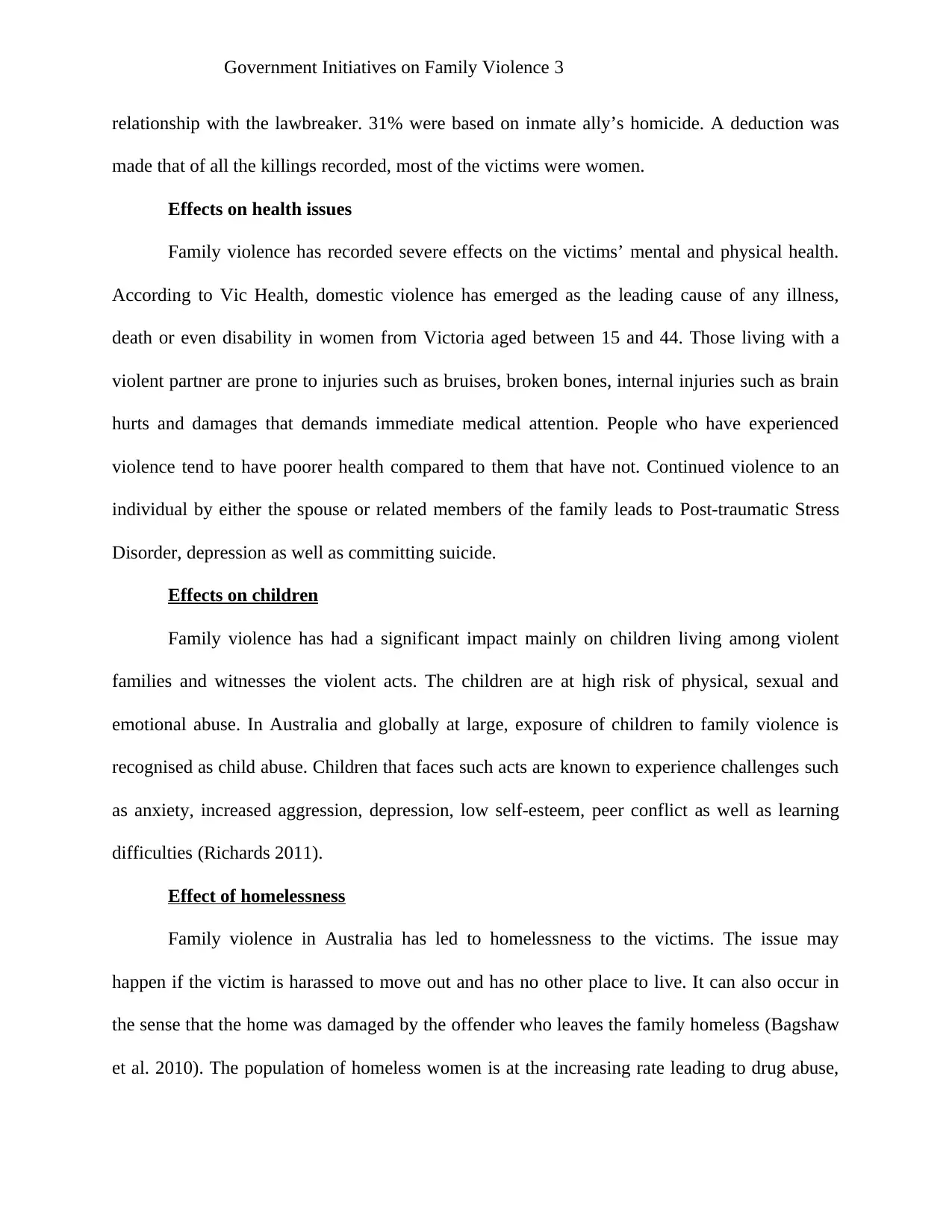
Government Initiatives on Family Violence 3
relationship with the lawbreaker. 31% were based on inmate ally’s homicide. A deduction was
made that of all the killings recorded, most of the victims were women.
Effects on health issues
Family violence has recorded severe effects on the victims’ mental and physical health.
According to Vic Health, domestic violence has emerged as the leading cause of any illness,
death or even disability in women from Victoria aged between 15 and 44. Those living with a
violent partner are prone to injuries such as bruises, broken bones, internal injuries such as brain
hurts and damages that demands immediate medical attention. People who have experienced
violence tend to have poorer health compared to them that have not. Continued violence to an
individual by either the spouse or related members of the family leads to Post-traumatic Stress
Disorder, depression as well as committing suicide.
Effects on children
Family violence has had a significant impact mainly on children living among violent
families and witnesses the violent acts. The children are at high risk of physical, sexual and
emotional abuse. In Australia and globally at large, exposure of children to family violence is
recognised as child abuse. Children that faces such acts are known to experience challenges such
as anxiety, increased aggression, depression, low self-esteem, peer conflict as well as learning
difficulties (Richards 2011).
Effect of homelessness
Family violence in Australia has led to homelessness to the victims. The issue may
happen if the victim is harassed to move out and has no other place to live. It can also occur in
the sense that the home was damaged by the offender who leaves the family homeless (Bagshaw
et al. 2010). The population of homeless women is at the increasing rate leading to drug abuse,
relationship with the lawbreaker. 31% were based on inmate ally’s homicide. A deduction was
made that of all the killings recorded, most of the victims were women.
Effects on health issues
Family violence has recorded severe effects on the victims’ mental and physical health.
According to Vic Health, domestic violence has emerged as the leading cause of any illness,
death or even disability in women from Victoria aged between 15 and 44. Those living with a
violent partner are prone to injuries such as bruises, broken bones, internal injuries such as brain
hurts and damages that demands immediate medical attention. People who have experienced
violence tend to have poorer health compared to them that have not. Continued violence to an
individual by either the spouse or related members of the family leads to Post-traumatic Stress
Disorder, depression as well as committing suicide.
Effects on children
Family violence has had a significant impact mainly on children living among violent
families and witnesses the violent acts. The children are at high risk of physical, sexual and
emotional abuse. In Australia and globally at large, exposure of children to family violence is
recognised as child abuse. Children that faces such acts are known to experience challenges such
as anxiety, increased aggression, depression, low self-esteem, peer conflict as well as learning
difficulties (Richards 2011).
Effect of homelessness
Family violence in Australia has led to homelessness to the victims. The issue may
happen if the victim is harassed to move out and has no other place to live. It can also occur in
the sense that the home was damaged by the offender who leaves the family homeless (Bagshaw
et al. 2010). The population of homeless women is at the increasing rate leading to drug abuse,
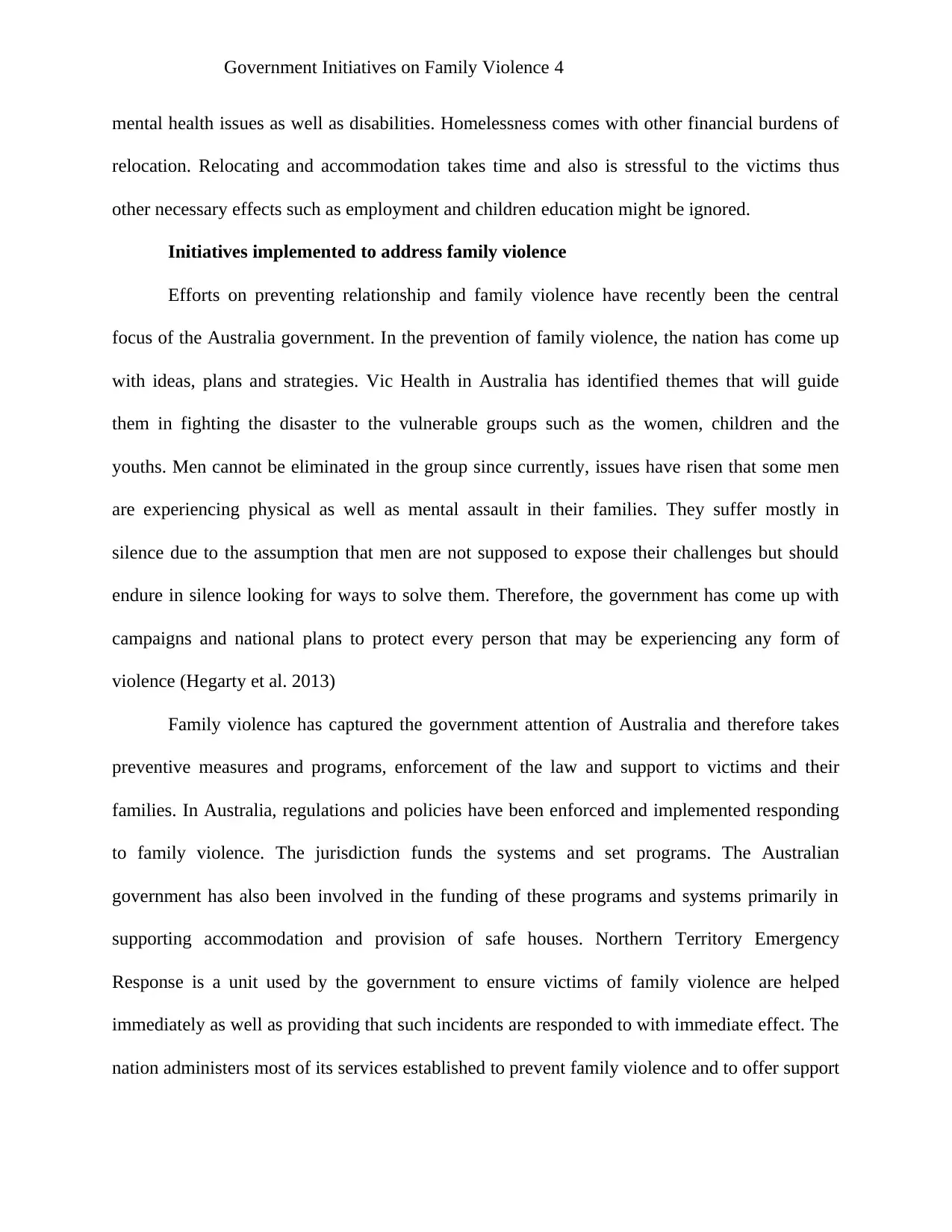
Government Initiatives on Family Violence 4
mental health issues as well as disabilities. Homelessness comes with other financial burdens of
relocation. Relocating and accommodation takes time and also is stressful to the victims thus
other necessary effects such as employment and children education might be ignored.
Initiatives implemented to address family violence
Efforts on preventing relationship and family violence have recently been the central
focus of the Australia government. In the prevention of family violence, the nation has come up
with ideas, plans and strategies. Vic Health in Australia has identified themes that will guide
them in fighting the disaster to the vulnerable groups such as the women, children and the
youths. Men cannot be eliminated in the group since currently, issues have risen that some men
are experiencing physical as well as mental assault in their families. They suffer mostly in
silence due to the assumption that men are not supposed to expose their challenges but should
endure in silence looking for ways to solve them. Therefore, the government has come up with
campaigns and national plans to protect every person that may be experiencing any form of
violence (Hegarty et al. 2013)
Family violence has captured the government attention of Australia and therefore takes
preventive measures and programs, enforcement of the law and support to victims and their
families. In Australia, regulations and policies have been enforced and implemented responding
to family violence. The jurisdiction funds the systems and set programs. The Australian
government has also been involved in the funding of these programs and systems primarily in
supporting accommodation and provision of safe houses. Northern Territory Emergency
Response is a unit used by the government to ensure victims of family violence are helped
immediately as well as providing that such incidents are responded to with immediate effect. The
nation administers most of its services established to prevent family violence and to offer support
mental health issues as well as disabilities. Homelessness comes with other financial burdens of
relocation. Relocating and accommodation takes time and also is stressful to the victims thus
other necessary effects such as employment and children education might be ignored.
Initiatives implemented to address family violence
Efforts on preventing relationship and family violence have recently been the central
focus of the Australia government. In the prevention of family violence, the nation has come up
with ideas, plans and strategies. Vic Health in Australia has identified themes that will guide
them in fighting the disaster to the vulnerable groups such as the women, children and the
youths. Men cannot be eliminated in the group since currently, issues have risen that some men
are experiencing physical as well as mental assault in their families. They suffer mostly in
silence due to the assumption that men are not supposed to expose their challenges but should
endure in silence looking for ways to solve them. Therefore, the government has come up with
campaigns and national plans to protect every person that may be experiencing any form of
violence (Hegarty et al. 2013)
Family violence has captured the government attention of Australia and therefore takes
preventive measures and programs, enforcement of the law and support to victims and their
families. In Australia, regulations and policies have been enforced and implemented responding
to family violence. The jurisdiction funds the systems and set programs. The Australian
government has also been involved in the funding of these programs and systems primarily in
supporting accommodation and provision of safe houses. Northern Territory Emergency
Response is a unit used by the government to ensure victims of family violence are helped
immediately as well as providing that such incidents are responded to with immediate effect. The
nation administers most of its services established to prevent family violence and to offer support
Secure Best Marks with AI Grader
Need help grading? Try our AI Grader for instant feedback on your assignments.
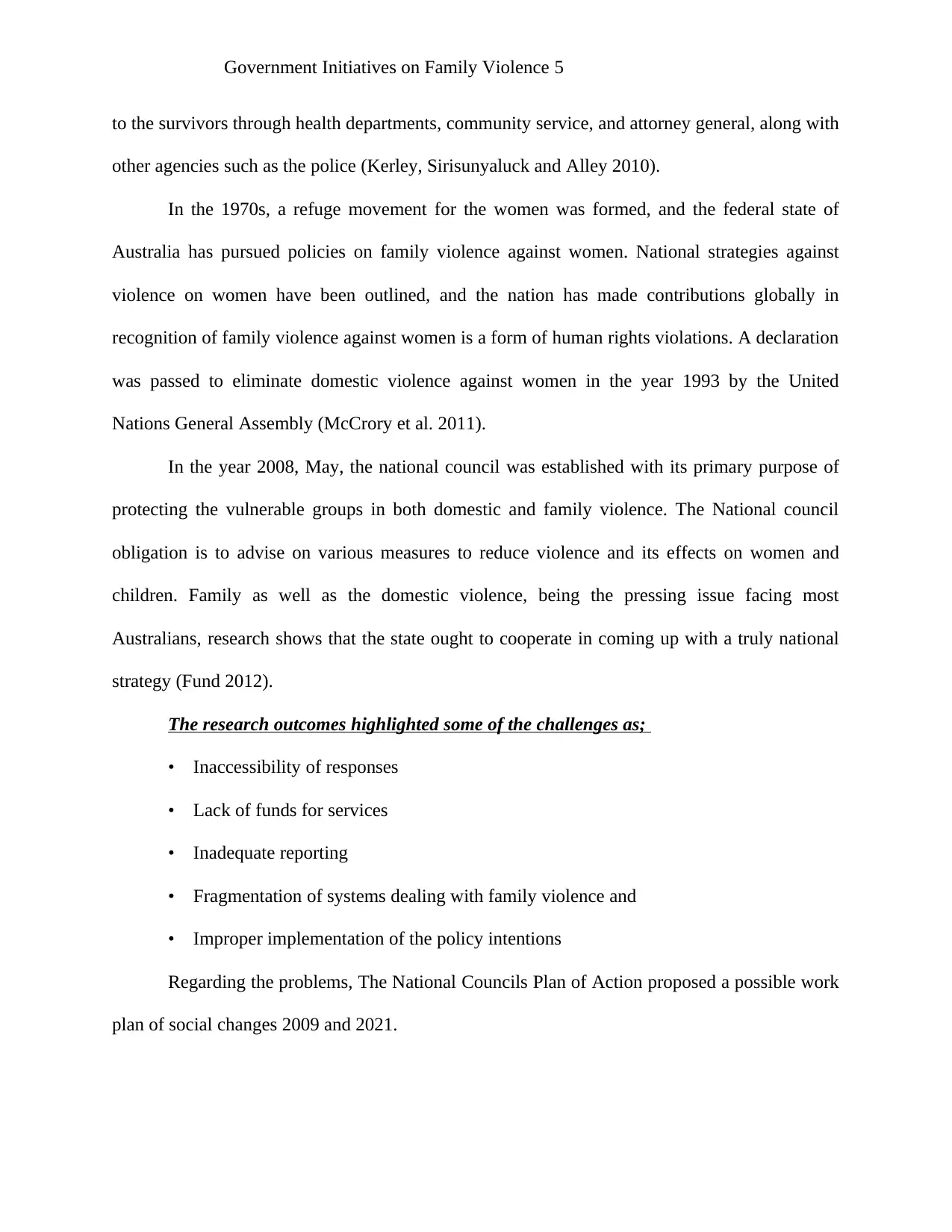
Government Initiatives on Family Violence 5
to the survivors through health departments, community service, and attorney general, along with
other agencies such as the police (Kerley, Sirisunyaluck and Alley 2010).
In the 1970s, a refuge movement for the women was formed, and the federal state of
Australia has pursued policies on family violence against women. National strategies against
violence on women have been outlined, and the nation has made contributions globally in
recognition of family violence against women is a form of human rights violations. A declaration
was passed to eliminate domestic violence against women in the year 1993 by the United
Nations General Assembly (McCrory et al. 2011).
In the year 2008, May, the national council was established with its primary purpose of
protecting the vulnerable groups in both domestic and family violence. The National council
obligation is to advise on various measures to reduce violence and its effects on women and
children. Family as well as the domestic violence, being the pressing issue facing most
Australians, research shows that the state ought to cooperate in coming up with a truly national
strategy (Fund 2012).
The research outcomes highlighted some of the challenges as;
• Inaccessibility of responses
• Lack of funds for services
• Inadequate reporting
• Fragmentation of systems dealing with family violence and
• Improper implementation of the policy intentions
Regarding the problems, The National Councils Plan of Action proposed a possible work
plan of social changes 2009 and 2021.
to the survivors through health departments, community service, and attorney general, along with
other agencies such as the police (Kerley, Sirisunyaluck and Alley 2010).
In the 1970s, a refuge movement for the women was formed, and the federal state of
Australia has pursued policies on family violence against women. National strategies against
violence on women have been outlined, and the nation has made contributions globally in
recognition of family violence against women is a form of human rights violations. A declaration
was passed to eliminate domestic violence against women in the year 1993 by the United
Nations General Assembly (McCrory et al. 2011).
In the year 2008, May, the national council was established with its primary purpose of
protecting the vulnerable groups in both domestic and family violence. The National council
obligation is to advise on various measures to reduce violence and its effects on women and
children. Family as well as the domestic violence, being the pressing issue facing most
Australians, research shows that the state ought to cooperate in coming up with a truly national
strategy (Fund 2012).
The research outcomes highlighted some of the challenges as;
• Inaccessibility of responses
• Lack of funds for services
• Inadequate reporting
• Fragmentation of systems dealing with family violence and
• Improper implementation of the policy intentions
Regarding the problems, The National Councils Plan of Action proposed a possible work
plan of social changes 2009 and 2021.
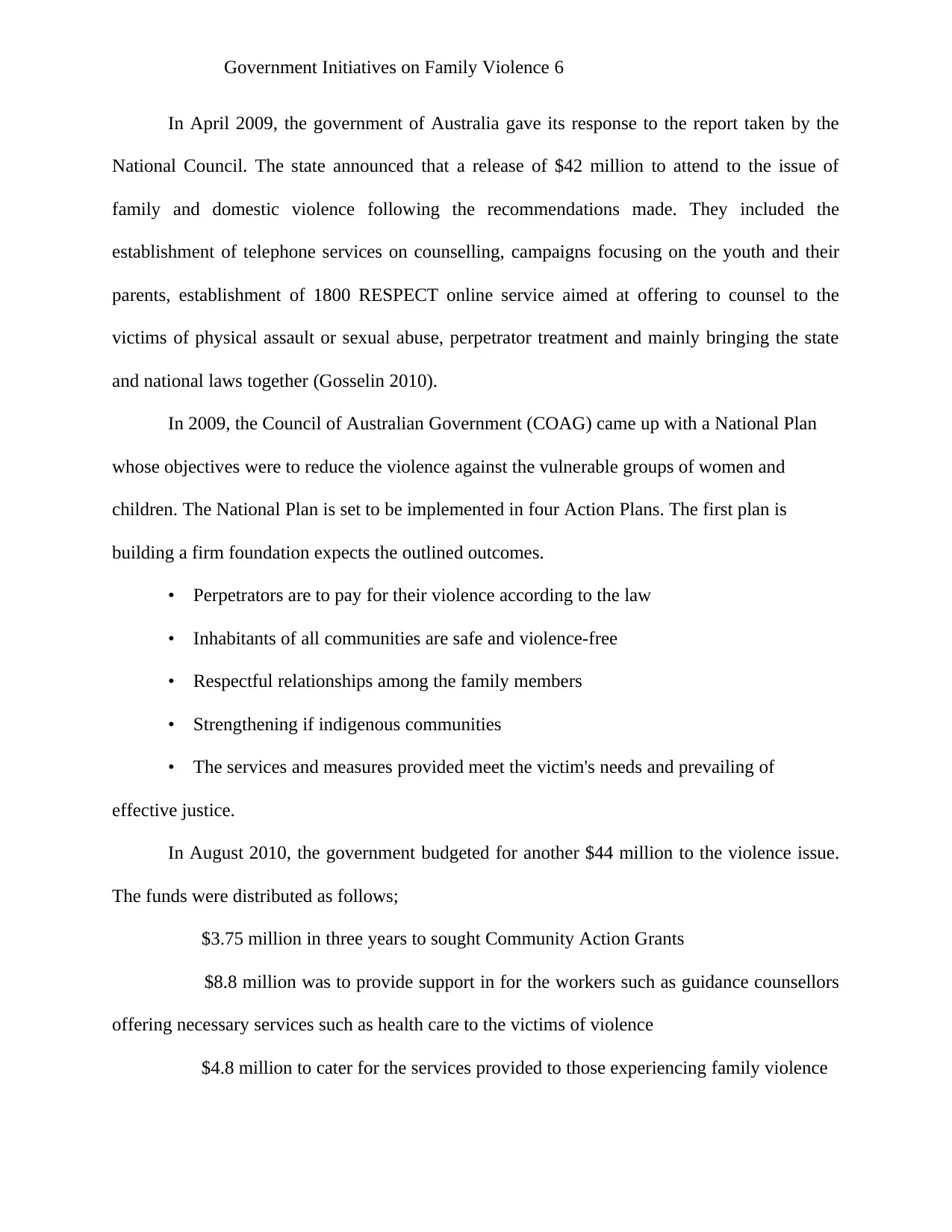
Government Initiatives on Family Violence 6
In April 2009, the government of Australia gave its response to the report taken by the
National Council. The state announced that a release of $42 million to attend to the issue of
family and domestic violence following the recommendations made. They included the
establishment of telephone services on counselling, campaigns focusing on the youth and their
parents, establishment of 1800 RESPECT online service aimed at offering to counsel to the
victims of physical assault or sexual abuse, perpetrator treatment and mainly bringing the state
and national laws together (Gosselin 2010).
In 2009, the Council of Australian Government (COAG) came up with a National Plan
whose objectives were to reduce the violence against the vulnerable groups of women and
children. The National Plan is set to be implemented in four Action Plans. The first plan is
building a firm foundation expects the outlined outcomes.
• Perpetrators are to pay for their violence according to the law
• Inhabitants of all communities are safe and violence-free
• Respectful relationships among the family members
• Strengthening if indigenous communities
• The services and measures provided meet the victim's needs and prevailing of
effective justice.
In August 2010, the government budgeted for another $44 million to the violence issue.
The funds were distributed as follows;
$3.75 million in three years to sought Community Action Grants
$8.8 million was to provide support in for the workers such as guidance counsellors
offering necessary services such as health care to the victims of violence
$4.8 million to cater for the services provided to those experiencing family violence
In April 2009, the government of Australia gave its response to the report taken by the
National Council. The state announced that a release of $42 million to attend to the issue of
family and domestic violence following the recommendations made. They included the
establishment of telephone services on counselling, campaigns focusing on the youth and their
parents, establishment of 1800 RESPECT online service aimed at offering to counsel to the
victims of physical assault or sexual abuse, perpetrator treatment and mainly bringing the state
and national laws together (Gosselin 2010).
In 2009, the Council of Australian Government (COAG) came up with a National Plan
whose objectives were to reduce the violence against the vulnerable groups of women and
children. The National Plan is set to be implemented in four Action Plans. The first plan is
building a firm foundation expects the outlined outcomes.
• Perpetrators are to pay for their violence according to the law
• Inhabitants of all communities are safe and violence-free
• Respectful relationships among the family members
• Strengthening if indigenous communities
• The services and measures provided meet the victim's needs and prevailing of
effective justice.
In August 2010, the government budgeted for another $44 million to the violence issue.
The funds were distributed as follows;
$3.75 million in three years to sought Community Action Grants
$8.8 million was to provide support in for the workers such as guidance counsellors
offering necessary services such as health care to the victims of violence
$4.8 million to cater for the services provided to those experiencing family violence
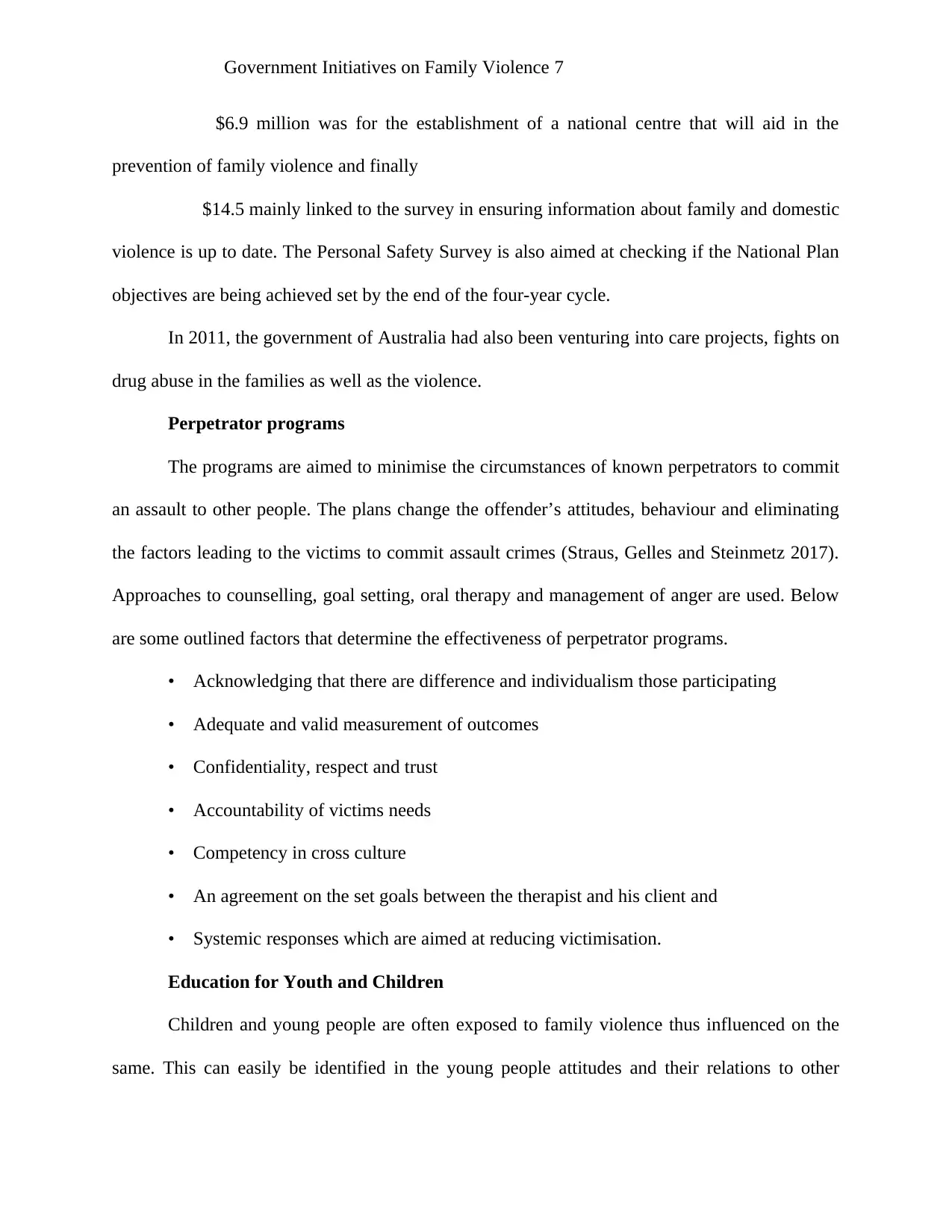
Government Initiatives on Family Violence 7
$6.9 million was for the establishment of a national centre that will aid in the
prevention of family violence and finally
$14.5 mainly linked to the survey in ensuring information about family and domestic
violence is up to date. The Personal Safety Survey is also aimed at checking if the National Plan
objectives are being achieved set by the end of the four-year cycle.
In 2011, the government of Australia had also been venturing into care projects, fights on
drug abuse in the families as well as the violence.
Perpetrator programs
The programs are aimed to minimise the circumstances of known perpetrators to commit
an assault to other people. The plans change the offender’s attitudes, behaviour and eliminating
the factors leading to the victims to commit assault crimes (Straus, Gelles and Steinmetz 2017).
Approaches to counselling, goal setting, oral therapy and management of anger are used. Below
are some outlined factors that determine the effectiveness of perpetrator programs.
• Acknowledging that there are difference and individualism those participating
• Adequate and valid measurement of outcomes
• Confidentiality, respect and trust
• Accountability of victims needs
• Competency in cross culture
• An agreement on the set goals between the therapist and his client and
• Systemic responses which are aimed at reducing victimisation.
Education for Youth and Children
Children and young people are often exposed to family violence thus influenced on the
same. This can easily be identified in the young people attitudes and their relations to other
$6.9 million was for the establishment of a national centre that will aid in the
prevention of family violence and finally
$14.5 mainly linked to the survey in ensuring information about family and domestic
violence is up to date. The Personal Safety Survey is also aimed at checking if the National Plan
objectives are being achieved set by the end of the four-year cycle.
In 2011, the government of Australia had also been venturing into care projects, fights on
drug abuse in the families as well as the violence.
Perpetrator programs
The programs are aimed to minimise the circumstances of known perpetrators to commit
an assault to other people. The plans change the offender’s attitudes, behaviour and eliminating
the factors leading to the victims to commit assault crimes (Straus, Gelles and Steinmetz 2017).
Approaches to counselling, goal setting, oral therapy and management of anger are used. Below
are some outlined factors that determine the effectiveness of perpetrator programs.
• Acknowledging that there are difference and individualism those participating
• Adequate and valid measurement of outcomes
• Confidentiality, respect and trust
• Accountability of victims needs
• Competency in cross culture
• An agreement on the set goals between the therapist and his client and
• Systemic responses which are aimed at reducing victimisation.
Education for Youth and Children
Children and young people are often exposed to family violence thus influenced on the
same. This can easily be identified in the young people attitudes and their relations to other
Paraphrase This Document
Need a fresh take? Get an instant paraphrase of this document with our AI Paraphraser
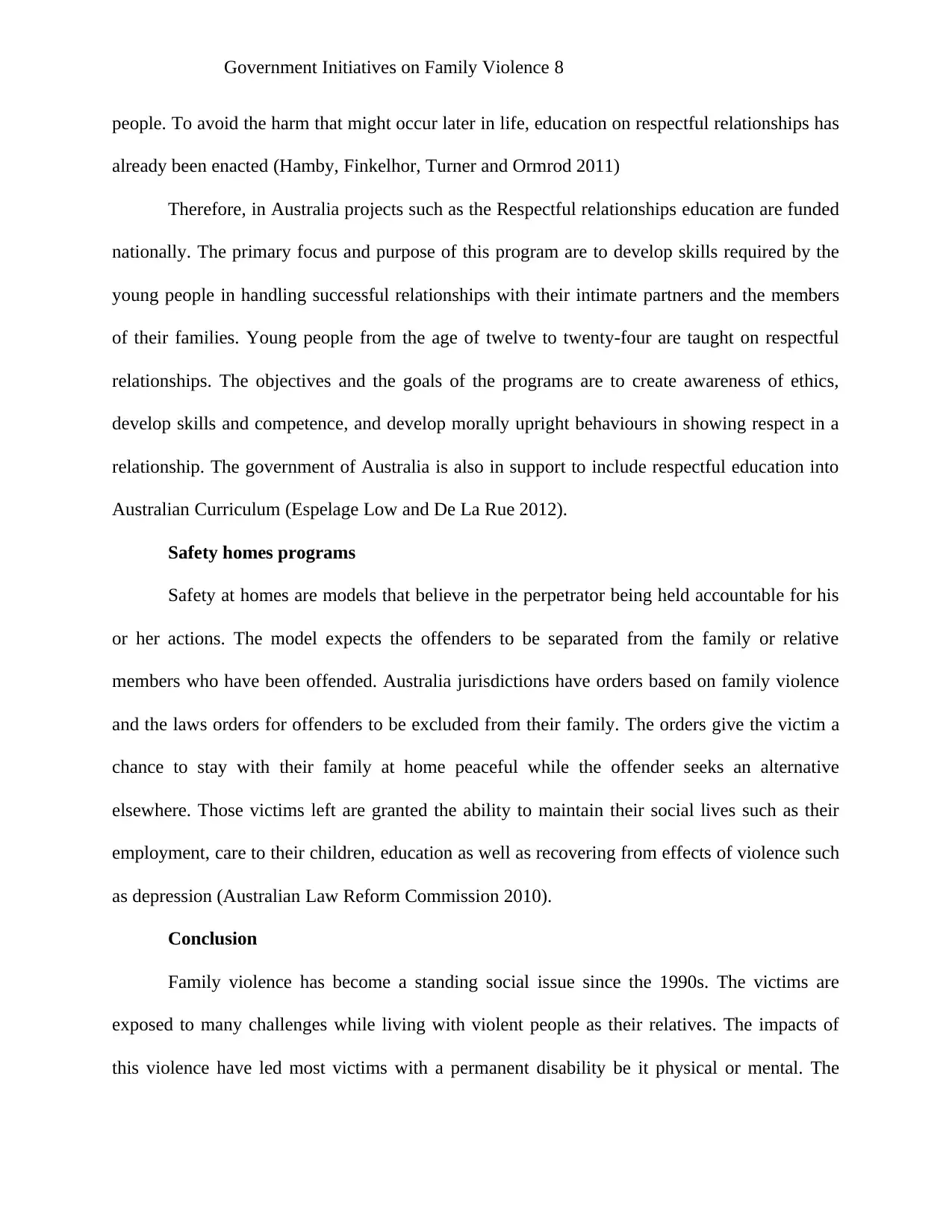
Government Initiatives on Family Violence 8
people. To avoid the harm that might occur later in life, education on respectful relationships has
already been enacted (Hamby, Finkelhor, Turner and Ormrod 2011)
Therefore, in Australia projects such as the Respectful relationships education are funded
nationally. The primary focus and purpose of this program are to develop skills required by the
young people in handling successful relationships with their intimate partners and the members
of their families. Young people from the age of twelve to twenty-four are taught on respectful
relationships. The objectives and the goals of the programs are to create awareness of ethics,
develop skills and competence, and develop morally upright behaviours in showing respect in a
relationship. The government of Australia is also in support to include respectful education into
Australian Curriculum (Espelage Low and De La Rue 2012).
Safety homes programs
Safety at homes are models that believe in the perpetrator being held accountable for his
or her actions. The model expects the offenders to be separated from the family or relative
members who have been offended. Australia jurisdictions have orders based on family violence
and the laws orders for offenders to be excluded from their family. The orders give the victim a
chance to stay with their family at home peaceful while the offender seeks an alternative
elsewhere. Those victims left are granted the ability to maintain their social lives such as their
employment, care to their children, education as well as recovering from effects of violence such
as depression (Australian Law Reform Commission 2010).
Conclusion
Family violence has become a standing social issue since the 1990s. The victims are
exposed to many challenges while living with violent people as their relatives. The impacts of
this violence have led most victims with a permanent disability be it physical or mental. The
people. To avoid the harm that might occur later in life, education on respectful relationships has
already been enacted (Hamby, Finkelhor, Turner and Ormrod 2011)
Therefore, in Australia projects such as the Respectful relationships education are funded
nationally. The primary focus and purpose of this program are to develop skills required by the
young people in handling successful relationships with their intimate partners and the members
of their families. Young people from the age of twelve to twenty-four are taught on respectful
relationships. The objectives and the goals of the programs are to create awareness of ethics,
develop skills and competence, and develop morally upright behaviours in showing respect in a
relationship. The government of Australia is also in support to include respectful education into
Australian Curriculum (Espelage Low and De La Rue 2012).
Safety homes programs
Safety at homes are models that believe in the perpetrator being held accountable for his
or her actions. The model expects the offenders to be separated from the family or relative
members who have been offended. Australia jurisdictions have orders based on family violence
and the laws orders for offenders to be excluded from their family. The orders give the victim a
chance to stay with their family at home peaceful while the offender seeks an alternative
elsewhere. Those victims left are granted the ability to maintain their social lives such as their
employment, care to their children, education as well as recovering from effects of violence such
as depression (Australian Law Reform Commission 2010).
Conclusion
Family violence has become a standing social issue since the 1990s. The victims are
exposed to many challenges while living with violent people as their relatives. The impacts of
this violence have led most victims with a permanent disability be it physical or mental. The
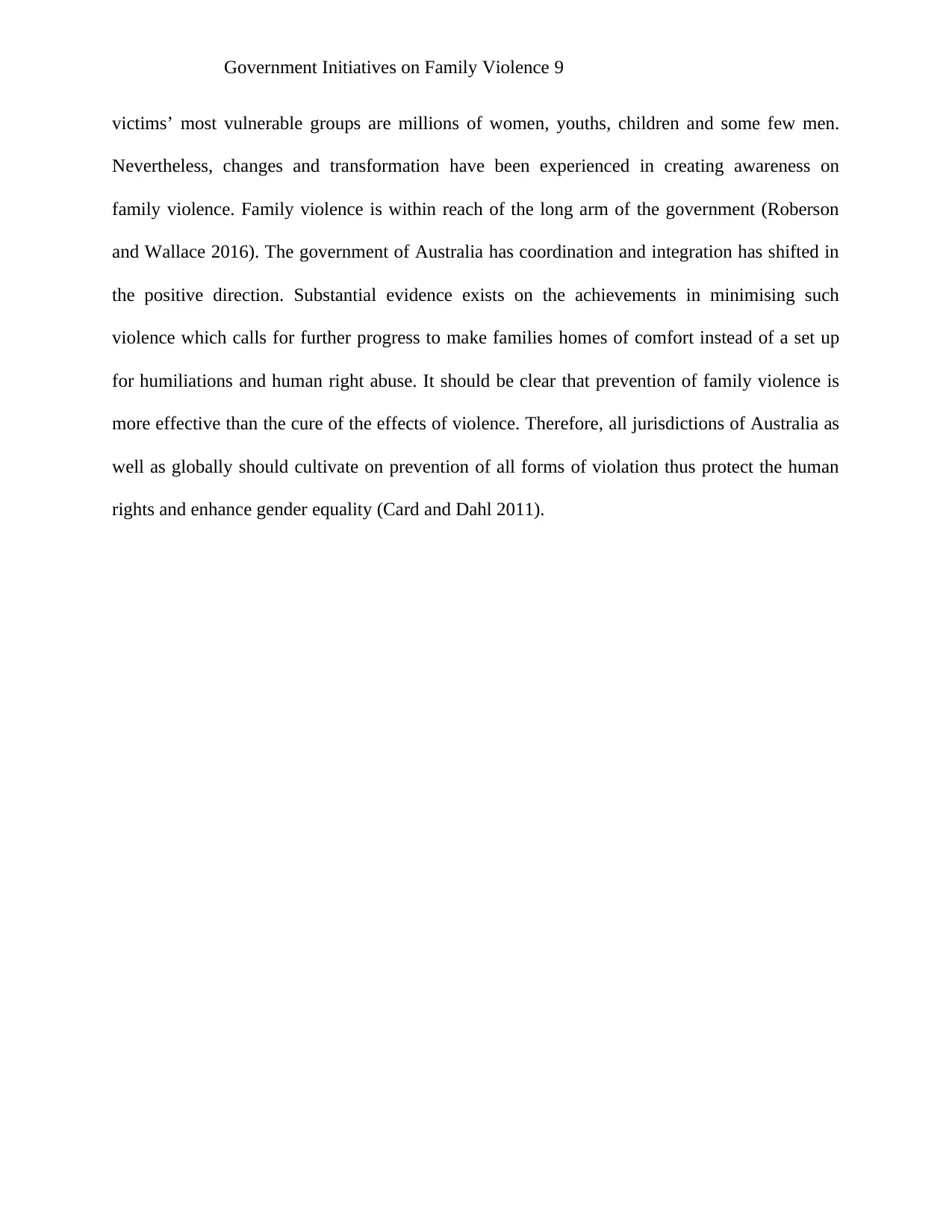
Government Initiatives on Family Violence 9
victims’ most vulnerable groups are millions of women, youths, children and some few men.
Nevertheless, changes and transformation have been experienced in creating awareness on
family violence. Family violence is within reach of the long arm of the government (Roberson
and Wallace 2016). The government of Australia has coordination and integration has shifted in
the positive direction. Substantial evidence exists on the achievements in minimising such
violence which calls for further progress to make families homes of comfort instead of a set up
for humiliations and human right abuse. It should be clear that prevention of family violence is
more effective than the cure of the effects of violence. Therefore, all jurisdictions of Australia as
well as globally should cultivate on prevention of all forms of violation thus protect the human
rights and enhance gender equality (Card and Dahl 2011).
victims’ most vulnerable groups are millions of women, youths, children and some few men.
Nevertheless, changes and transformation have been experienced in creating awareness on
family violence. Family violence is within reach of the long arm of the government (Roberson
and Wallace 2016). The government of Australia has coordination and integration has shifted in
the positive direction. Substantial evidence exists on the achievements in minimising such
violence which calls for further progress to make families homes of comfort instead of a set up
for humiliations and human right abuse. It should be clear that prevention of family violence is
more effective than the cure of the effects of violence. Therefore, all jurisdictions of Australia as
well as globally should cultivate on prevention of all forms of violation thus protect the human
rights and enhance gender equality (Card and Dahl 2011).
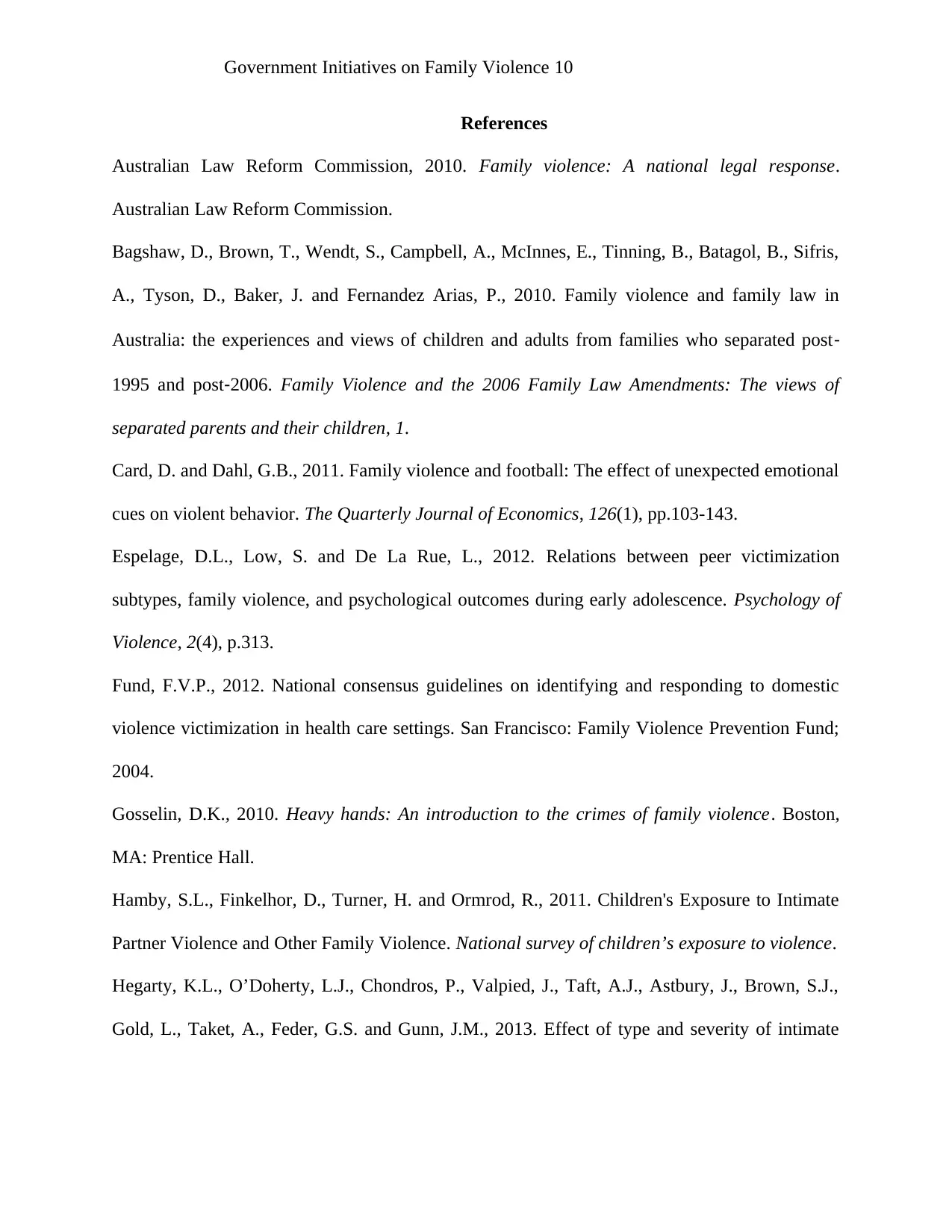
Government Initiatives on Family Violence 10
References
Australian Law Reform Commission, 2010. Family violence: A national legal response.
Australian Law Reform Commission.
Bagshaw, D., Brown, T., Wendt, S., Campbell, A., McInnes, E., Tinning, B., Batagol, B., Sifris,
A., Tyson, D., Baker, J. and Fernandez Arias, P., 2010. Family violence and family law in
Australia: the experiences and views of children and adults from families who separated post‐
1995 and post‐2006. Family Violence and the 2006 Family Law Amendments: The views of
separated parents and their children, 1.
Card, D. and Dahl, G.B., 2011. Family violence and football: The effect of unexpected emotional
cues on violent behavior. The Quarterly Journal of Economics, 126(1), pp.103-143.
Espelage, D.L., Low, S. and De La Rue, L., 2012. Relations between peer victimization
subtypes, family violence, and psychological outcomes during early adolescence. Psychology of
Violence, 2(4), p.313.
Fund, F.V.P., 2012. National consensus guidelines on identifying and responding to domestic
violence victimization in health care settings. San Francisco: Family Violence Prevention Fund;
2004.
Gosselin, D.K., 2010. Heavy hands: An introduction to the crimes of family violence. Boston,
MA: Prentice Hall.
Hamby, S.L., Finkelhor, D., Turner, H. and Ormrod, R., 2011. Children's Exposure to Intimate
Partner Violence and Other Family Violence. National survey of children’s exposure to violence.
Hegarty, K.L., O’Doherty, L.J., Chondros, P., Valpied, J., Taft, A.J., Astbury, J., Brown, S.J.,
Gold, L., Taket, A., Feder, G.S. and Gunn, J.M., 2013. Effect of type and severity of intimate
References
Australian Law Reform Commission, 2010. Family violence: A national legal response.
Australian Law Reform Commission.
Bagshaw, D., Brown, T., Wendt, S., Campbell, A., McInnes, E., Tinning, B., Batagol, B., Sifris,
A., Tyson, D., Baker, J. and Fernandez Arias, P., 2010. Family violence and family law in
Australia: the experiences and views of children and adults from families who separated post‐
1995 and post‐2006. Family Violence and the 2006 Family Law Amendments: The views of
separated parents and their children, 1.
Card, D. and Dahl, G.B., 2011. Family violence and football: The effect of unexpected emotional
cues on violent behavior. The Quarterly Journal of Economics, 126(1), pp.103-143.
Espelage, D.L., Low, S. and De La Rue, L., 2012. Relations between peer victimization
subtypes, family violence, and psychological outcomes during early adolescence. Psychology of
Violence, 2(4), p.313.
Fund, F.V.P., 2012. National consensus guidelines on identifying and responding to domestic
violence victimization in health care settings. San Francisco: Family Violence Prevention Fund;
2004.
Gosselin, D.K., 2010. Heavy hands: An introduction to the crimes of family violence. Boston,
MA: Prentice Hall.
Hamby, S.L., Finkelhor, D., Turner, H. and Ormrod, R., 2011. Children's Exposure to Intimate
Partner Violence and Other Family Violence. National survey of children’s exposure to violence.
Hegarty, K.L., O’Doherty, L.J., Chondros, P., Valpied, J., Taft, A.J., Astbury, J., Brown, S.J.,
Gold, L., Taket, A., Feder, G.S. and Gunn, J.M., 2013. Effect of type and severity of intimate
Secure Best Marks with AI Grader
Need help grading? Try our AI Grader for instant feedback on your assignments.
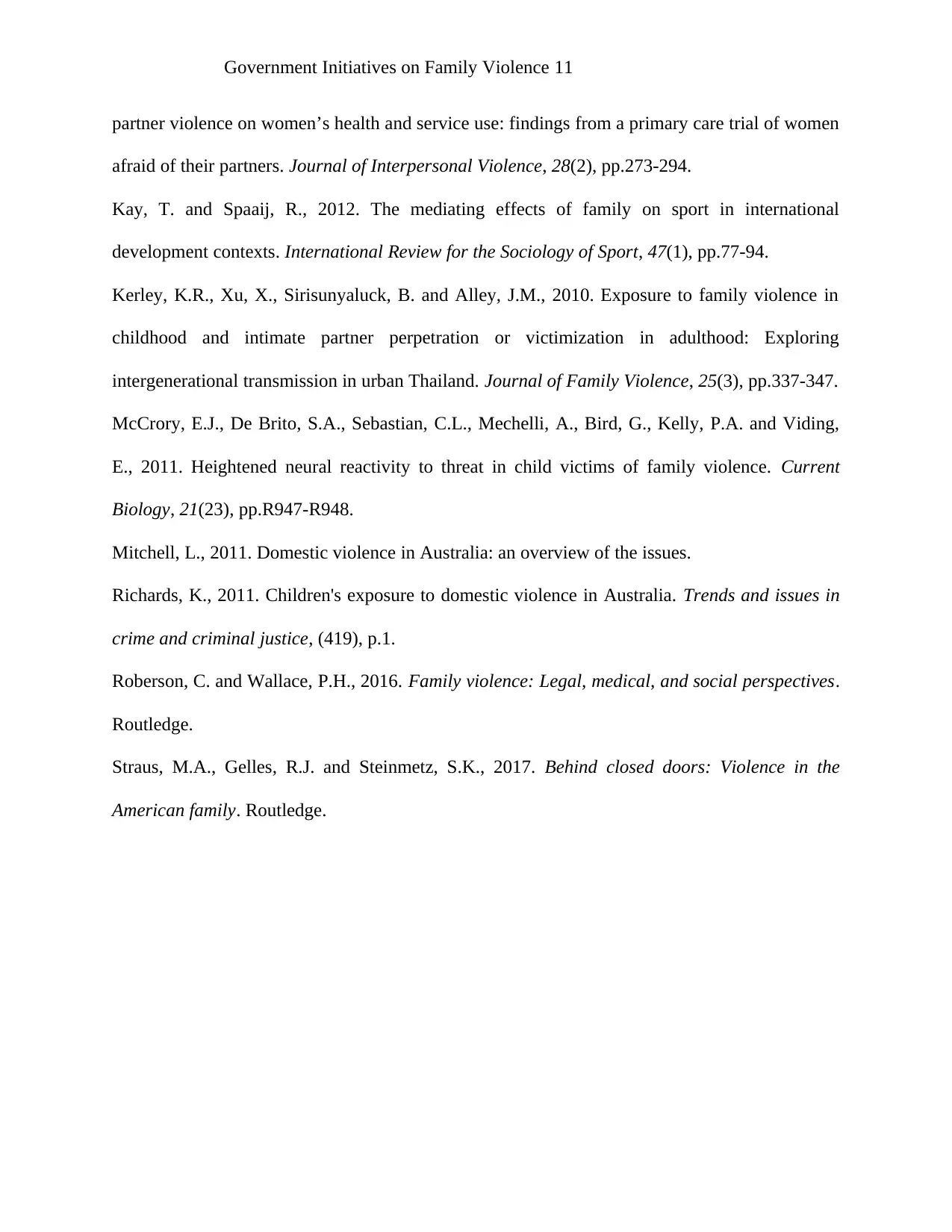
Government Initiatives on Family Violence 11
partner violence on women’s health and service use: findings from a primary care trial of women
afraid of their partners. Journal of Interpersonal Violence, 28(2), pp.273-294.
Kay, T. and Spaaij, R., 2012. The mediating effects of family on sport in international
development contexts. International Review for the Sociology of Sport, 47(1), pp.77-94.
Kerley, K.R., Xu, X., Sirisunyaluck, B. and Alley, J.M., 2010. Exposure to family violence in
childhood and intimate partner perpetration or victimization in adulthood: Exploring
intergenerational transmission in urban Thailand. Journal of Family Violence, 25(3), pp.337-347.
McCrory, E.J., De Brito, S.A., Sebastian, C.L., Mechelli, A., Bird, G., Kelly, P.A. and Viding,
E., 2011. Heightened neural reactivity to threat in child victims of family violence. Current
Biology, 21(23), pp.R947-R948.
Mitchell, L., 2011. Domestic violence in Australia: an overview of the issues.
Richards, K., 2011. Children's exposure to domestic violence in Australia. Trends and issues in
crime and criminal justice, (419), p.1.
Roberson, C. and Wallace, P.H., 2016. Family violence: Legal, medical, and social perspectives.
Routledge.
Straus, M.A., Gelles, R.J. and Steinmetz, S.K., 2017. Behind closed doors: Violence in the
American family. Routledge.
partner violence on women’s health and service use: findings from a primary care trial of women
afraid of their partners. Journal of Interpersonal Violence, 28(2), pp.273-294.
Kay, T. and Spaaij, R., 2012. The mediating effects of family on sport in international
development contexts. International Review for the Sociology of Sport, 47(1), pp.77-94.
Kerley, K.R., Xu, X., Sirisunyaluck, B. and Alley, J.M., 2010. Exposure to family violence in
childhood and intimate partner perpetration or victimization in adulthood: Exploring
intergenerational transmission in urban Thailand. Journal of Family Violence, 25(3), pp.337-347.
McCrory, E.J., De Brito, S.A., Sebastian, C.L., Mechelli, A., Bird, G., Kelly, P.A. and Viding,
E., 2011. Heightened neural reactivity to threat in child victims of family violence. Current
Biology, 21(23), pp.R947-R948.
Mitchell, L., 2011. Domestic violence in Australia: an overview of the issues.
Richards, K., 2011. Children's exposure to domestic violence in Australia. Trends and issues in
crime and criminal justice, (419), p.1.
Roberson, C. and Wallace, P.H., 2016. Family violence: Legal, medical, and social perspectives.
Routledge.
Straus, M.A., Gelles, R.J. and Steinmetz, S.K., 2017. Behind closed doors: Violence in the
American family. Routledge.
1 out of 11
Related Documents
Your All-in-One AI-Powered Toolkit for Academic Success.
+13062052269
info@desklib.com
Available 24*7 on WhatsApp / Email
![[object Object]](/_next/static/media/star-bottom.7253800d.svg)
Unlock your academic potential
© 2024 | Zucol Services PVT LTD | All rights reserved.




